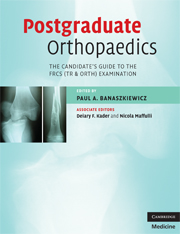Book contents
- Frontmatter
- Contents
- List of contributors
- Foreword by Mr Peter Gibson
- Preface
- Glossary
- Section 1 The FRCS (Tr & Orth) examination
- Section 2 The written paper
- Section 3 The clininicals
- Section 4 Adult elective orthopaedics oral
- 14 General oral guidance
- 15 Shoulder and elbow oral core topics
- 16 Hip oral core topics
- 17 Knee oral core topics
- 18 Foot and ankle oral core topics
- 19 Spine oral core topics
- Section 5 The hand oral
- Section 6 The paediatric oral
- Section 7 The trauma oral
- Section 8 The basic science oral
- Section 9 Miscellaneous topics
- Index
15 - Shoulder and elbow oral core topics
from Section 4 - Adult elective orthopaedics oral
Published online by Cambridge University Press: 22 August 2009
- Frontmatter
- Contents
- List of contributors
- Foreword by Mr Peter Gibson
- Preface
- Glossary
- Section 1 The FRCS (Tr & Orth) examination
- Section 2 The written paper
- Section 3 The clininicals
- Section 4 Adult elective orthopaedics oral
- 14 General oral guidance
- 15 Shoulder and elbow oral core topics
- 16 Hip oral core topics
- 17 Knee oral core topics
- 18 Foot and ankle oral core topics
- 19 Spine oral core topics
- Section 5 The hand oral
- Section 6 The paediatric oral
- Section 7 The trauma oral
- Section 8 The basic science oral
- Section 9 Miscellaneous topics
- Index
Summary
Acromioclavicular joint arthritis
The acromioclavicular joint (ACJ) contains a fibrocartilaginous disc, which may be involved in the degenerative process. Stability of the joint depends partly on the superior (stronger) and inferior (weaker) AC ligaments, and partly on the conoid and trapezoid ligaments that connect the coracoid and the clavicle.
Causes
Primary osteoarthritis
Post-traumatic arthritis (e.g. after Grade I and II ACJ disruptions)
Distal clavicular osteolysis, due to repetitive microtrauma or fatigue failure associated particularly with weight training
Rheumatoid arthritis, in which ACJ pathology may be an under-diagnosed cause of pain
Assessment
The main symptom is pain. This is usually well localized to the joint, in contrast to the distally radiating pain of subacromial impingement. The two diagnoses frequently coexist, however, and inferior osteophytes associated with ACJ osteoarthritis may contribute to impingement. Patients have pain on working with their arms raised, and examination reveals a high painful arc above 120° on both active and passive movements. The cross body adduction test also produces localized pain, and local anaesthetic ACJ injection is useful both diagnostically and in terms of predicting likely response to surgery.
The ACJ is seen on standard AP and axillary shoulder radiographs. The Zanca view may be useful for specifically imaging the AC joint. This uses an X-ray beam angled 10°–15° superiorly and a decreased kilovoltage to avoid the overexposure typically found on standard radiographs.
Management
Conservative, with activity modification, NSAIDs, steroid injections, etc. Physiotherapy may be used, although there is little evidence for its effectiveness in ACJ arthritis
[…]
- Type
- Chapter
- Information
- Postgraduate OrthopaedicsThe Candidate's Guide to the FRCS (TR & Orth) Examination, pp. 138 - 154Publisher: Cambridge University PressPrint publication year: 2008



